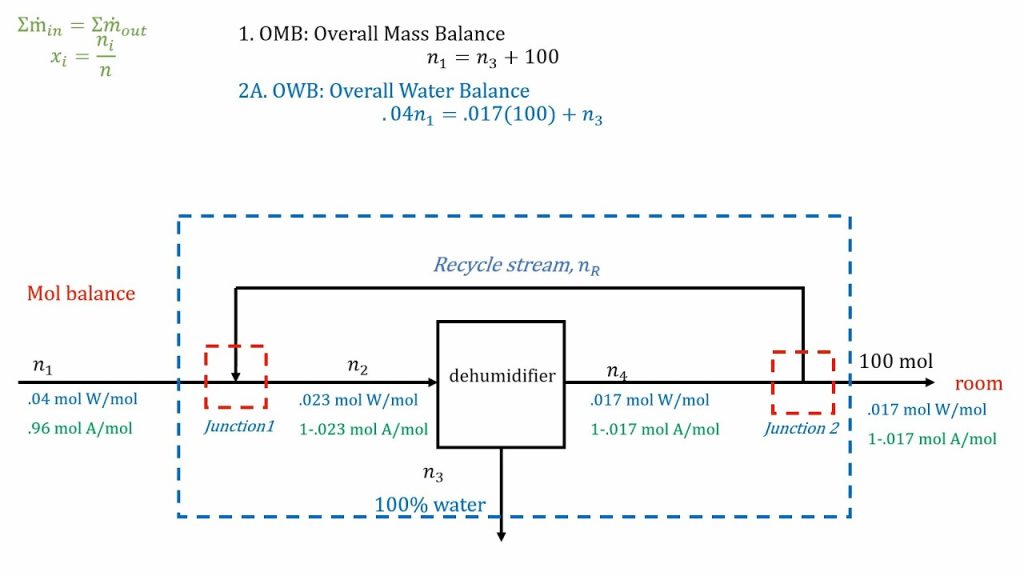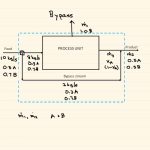One of the more common processing configurations is the material recycle structure.

These are particularly useful for reactors, where they allow better control of reactor selectivity when multiple reactions occur.
When we study recycle systems, we are often asked to calculate the recycle ratio. Usually, this is found by dividing the mass flow of the recycle stream by the mass flow of the “fresh feed” entering the system. In the industrial world, recycle ratios have important consequences for system performance and operating costs.
A common recycle structure is the reactor/separator

which is used to recover unreacted material and return it to the reactor. The “separator” may be a single piece of equipment or it may be an entire process on its own.
A related process structure is the bypass system

One use of bypass is to obtain precise control of the output stream, as when a small wet air stream bypasses a drier so that the output humidity can be regulated.
Solving Recycle and Bypass Problems
The methods for solving recycle and bypass problems are basically the same. In the steady state, there is no buildup or depletion of material within the system or recycle stream of a properly designed and operated process.
When solving, you can write balances (total material or component) around:
- the entire process structure
- the mixing point
- the splitter
- the processing unit (inside the recycle/bypass)
Only three of these will be independent (the fourth is a linear combination).
If you pick the right balances, you may be able to organize the problem for sequential solution. In particular, when you write the balance around the entire process system, terms describing the recycle/bypass stream do not appear; only the fresh feed and the product are required.
Example:
Himmelblau Example 2.21, p. 118 Given the process shown, find the recycle flow in pounds/hour, the production rate of potassium nitrate, and the recycle ratio.

You are asked to find three things: (i) the recycle flow (labeled R on the drawing), (ii) the production rate (labeled C on the drawing), and (iii) the recycle ratio, which will be calculated as R/10000 if we don’t change the basis.
The sketch is already done, so we need to label the variables. Let’s call the fresh feed F. If we look over the compositions, we’ll note that they are not consistently represented. Two are given as %KNO3, one as %H2O, and one as lb KNO3 per lb H2O. We’d usually prefer all the numbers to be in percent, so let’s do the problem using percent nitrate. Shifting the water percentage to nitrate is easy, just subtract from 100. The other stream (R) requires a calculation.
Do we really need to calculate the mass fraction nitrate in R? Since we’re asked two questions about the stream, it seems almost certain. To do that calculation, look at the composition given and choose a basis for computing the composition (we can change the basis for the rest of the problem).
Basis: : 1 lb H2O in stream R

And we have all the compositions in terms of mass fractions.
Now we’re ready to write balance equations. We’re given F, xF, W, xW = 0, xM, xC, and xR. Unknowns are W, M, C, and R. The problem asks for R, C, and R/F. Which balances can we write? Which should we write?
We can write:
- On the entire system — a total material, a nitrate, and/or a water balance
- On the evaporator — a total material, a nitrate, and/or a water balance
- On the crystallizer– a total material, a nitrate, and/or a water balance
- On the mixing point– a total material, a nitrate, and/or a water balance
The system balances will only involve two unknowns (W and C), one of which is a desired answer. Moreover, since there is no nitrate in stream W, there is a zero term. Thus I’m going to start with a nitrate balance on the system.

Now, W can be easily obtained by a total material balance on the system, if I need it.
The next target is R. It will show up in the evaporator, crystallizer, or mixing point balance. Unknowns in the evaporator balance are R, M, and (R+F); in the crystallizer R and M, and in the mixing point balance R and (R+F). Note that having found C, I’ve reduced the number of unknowns in the crystallizer balance relative to the others, so we’ll start there. There are still two unknowns, but this can be resolved by solving both the total and nitrate balances.

It is now simple to determine the recycle ratio



